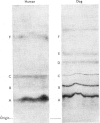Abstract
Bilirubin and its conjugates were extracted from either dog gall-bladder bile or bile-containing human duodenal juice into chloroform containing 10mm-tetraheptylammonium chloride. The intact bilirubin tetrapyrroles were then separated by t.l.c. Structural elucidation was made after coupling of the individual pigments with diazonium salts. Four azopigments were detected: azopigment αo or dipyrrolic azobilirubin; azopigment δ or dipyrrolic azobilirubin monoglucuronide; azopigment α3 or dipyrrolic azobilirubin monoglucoside; and, from dog gall-bladder bile, azopigment α2. The last conjugate required further verification of its structure. After methanolysis, it was shown by combined g.l.c.–mass spectrometry to contain xylose in a 1:1 molar ratio with the azopigments of bilirubin. Human bile contained 86% bilirubin diglucuronide, 7% bilirubin monoglucuronide monoglucoside diester, 4% bilirubin monoglucuronide and 3% bilirubin. Dog gall-bladder bile had a considerably different composition; it contained 47% bilirubin diglucuronide, 40% bilirubin monoglucuronide monoglucoside diester, 8% bilirubin monoglucuronide, 4% bilirubin diglucoside, 1–2% bilirubin and traces of conjugates containing xylose. The total bilirubin content and proportions of the conjugates did not change in bile that was frozen and stored at −20°C under N2, whereas in the chloroform/tetraheptylammonium chloride extract, similarly stored, total pigment was slowly lost and the diglucuronide conjugate converted into the monoglucuronide.
Full text
PDF
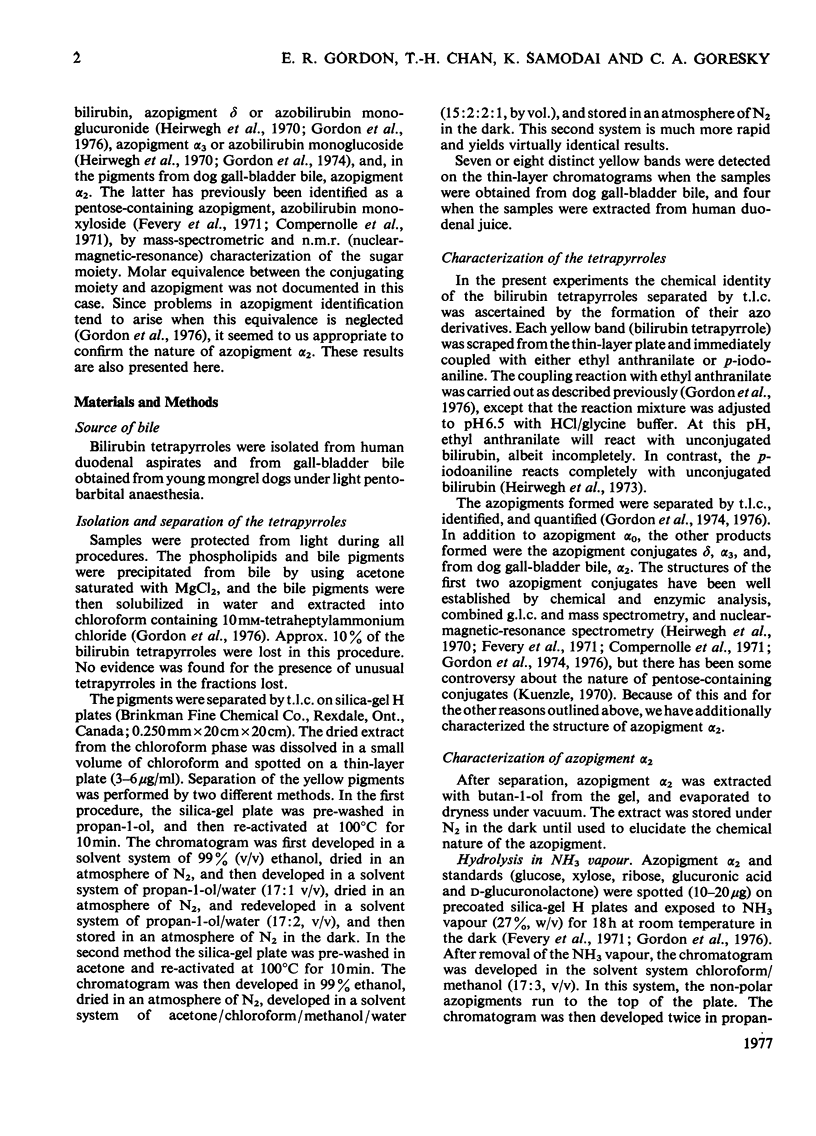
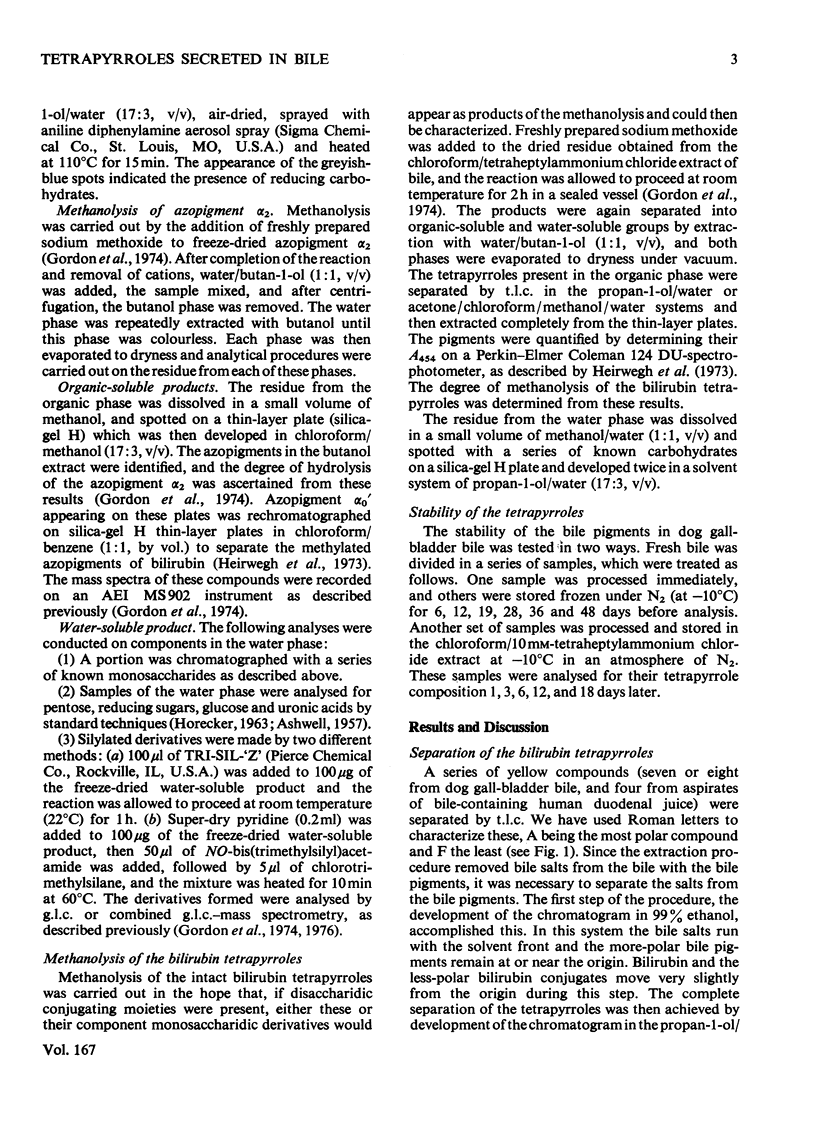
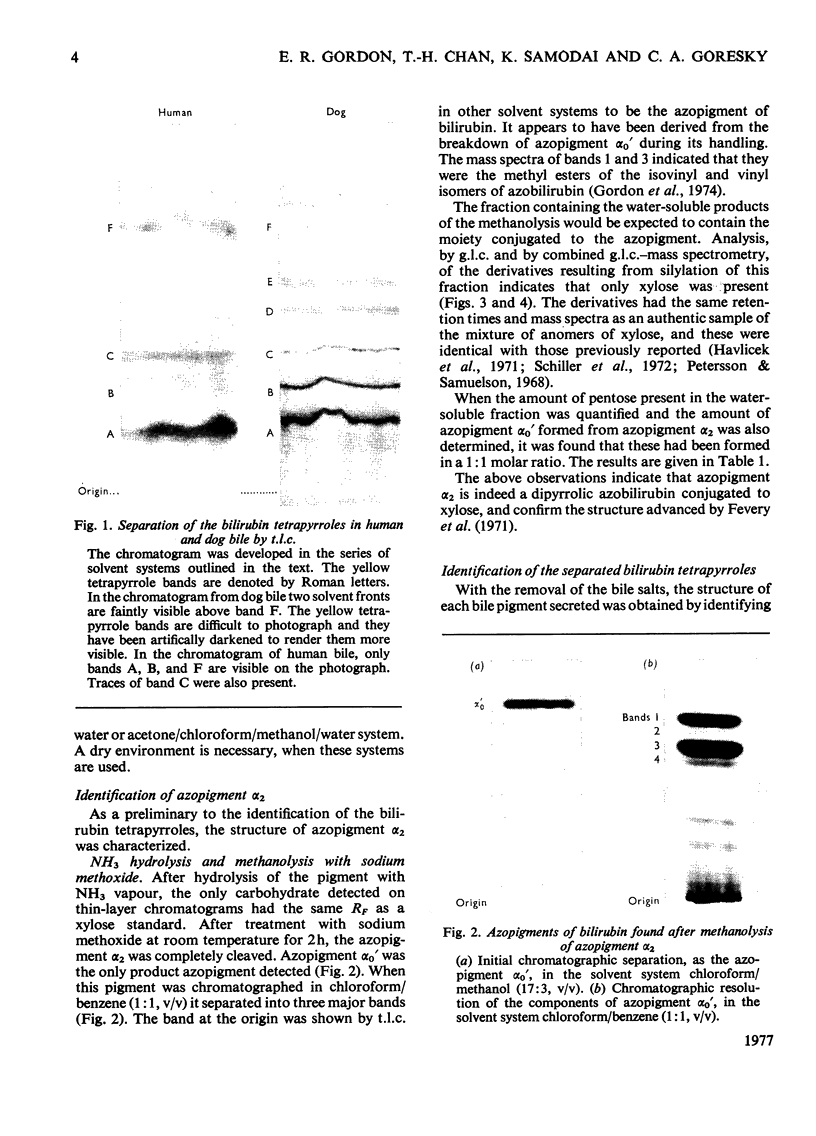
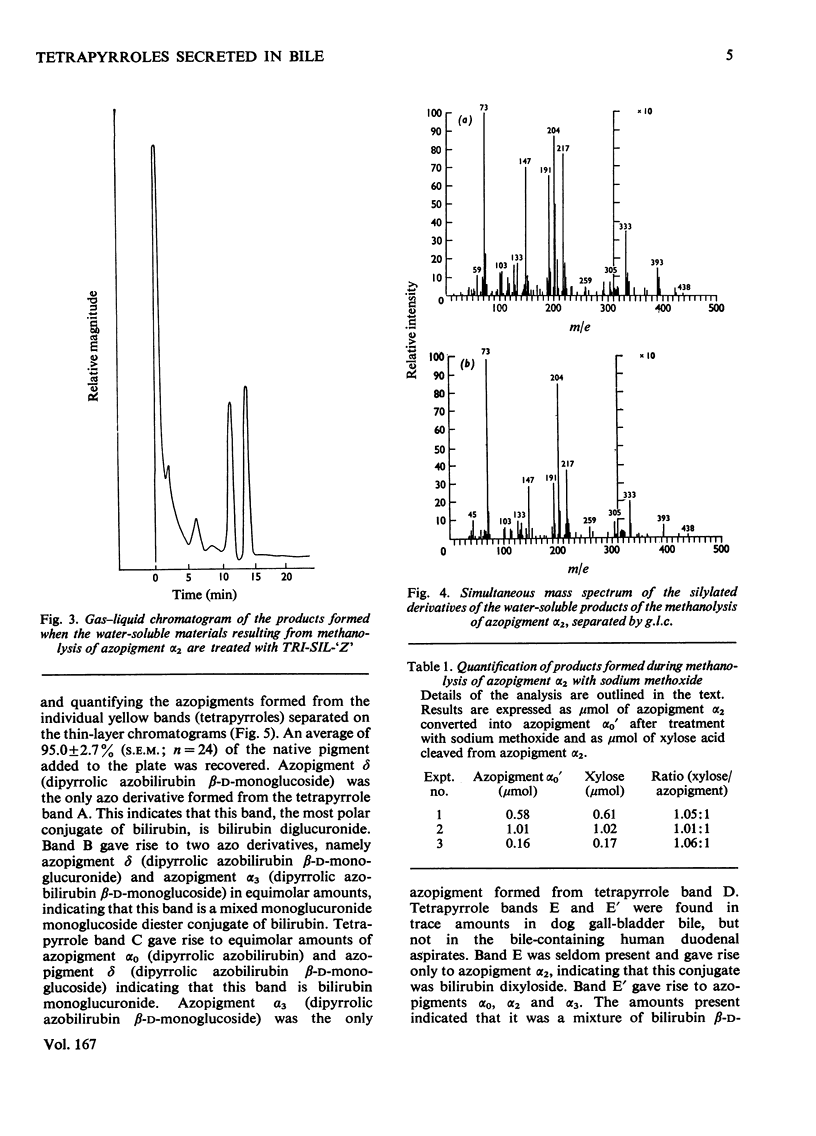
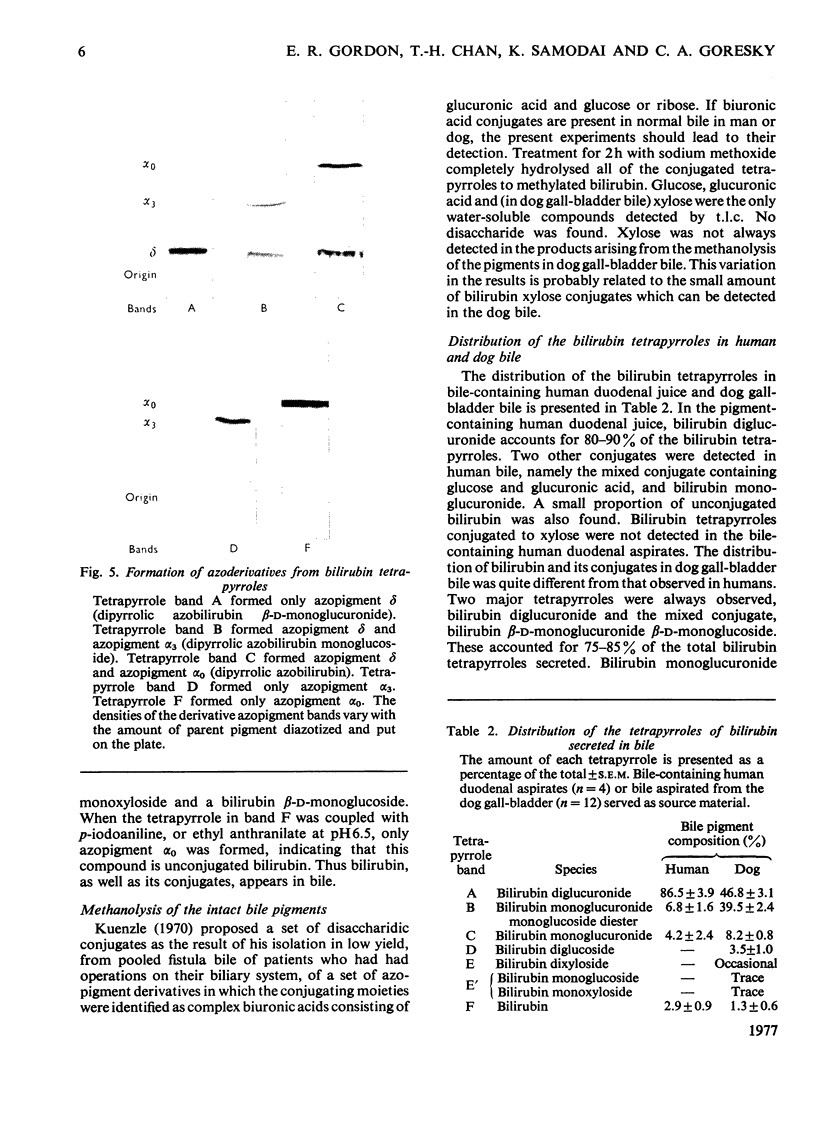

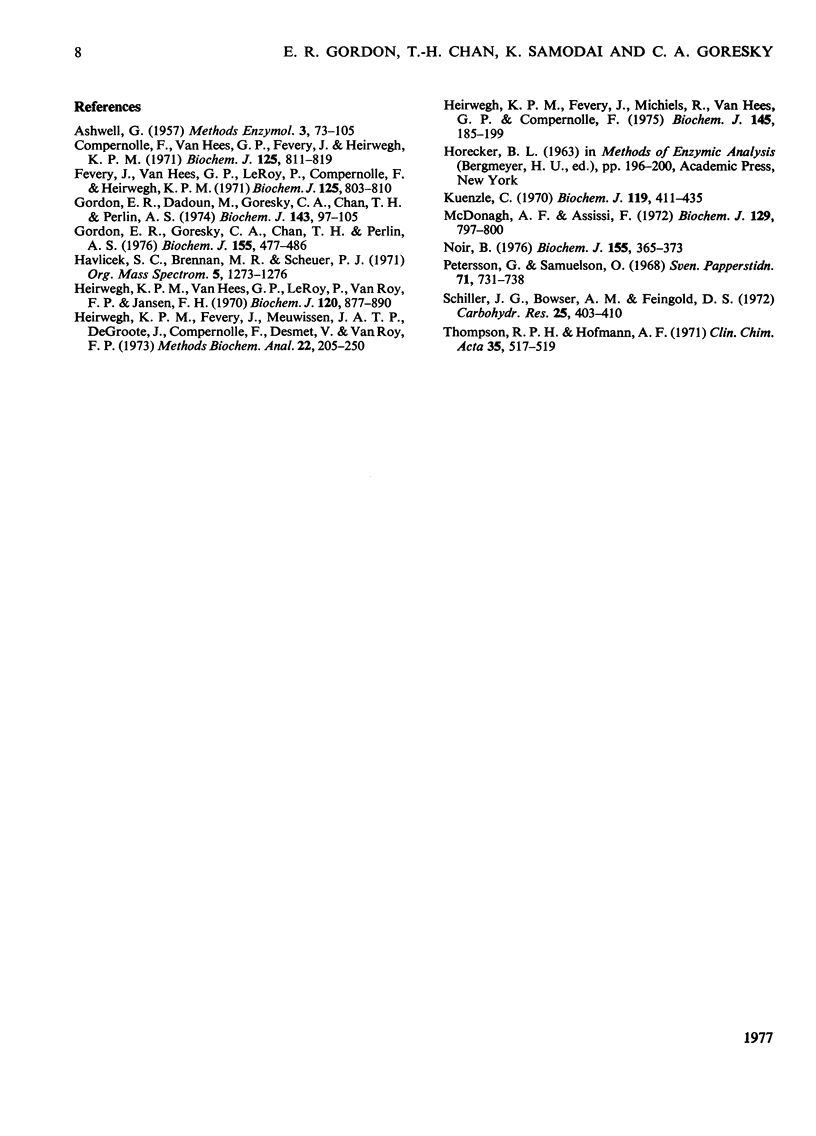
Images in this article
Selected References
These references are in PubMed. This may not be the complete list of references from this article.
- Compernolle F., Van Hees G. P., Fevery J., Heirwegh K. P. Mass-spectrometric structure elucidation of dog bile azopigments as the acyl glycosides of glucopyranose and xylopyranose. Biochem J. 1971 Dec;125(3):811–819. doi: 10.1042/bj1250811. [DOI] [PMC free article] [PubMed] [Google Scholar]
- Fevery J., Van Hees G. P., Leroy P., Compernolle F., Heirwegh K. P. Excretion in dog bile of glucose and xylose conjugates of bilirubin. Biochem J. 1971 Dec;125(3):803–810. doi: 10.1042/bj1250803. [DOI] [PMC free article] [PubMed] [Google Scholar]
- Gordon E. R., Dadoun M., Goresky C. A., Chan T. H., Perlin A. S. The isolation of an azobilirubin beta-D-monoglucoside from dog gall-bladder bile. Biochem J. 1974 Oct;143(1):97–105. doi: 10.1042/bj1430097. [DOI] [PMC free article] [PubMed] [Google Scholar]
- Gordon E. R., Goresky C. A., Chang T. H., Perlin A. S. The isolation and characterization of bilirubin diglucuronide, the major bilirubin conjugate in dog and human bile. Biochem J. 1976 Jun 1;155(3):477–486. doi: 10.1042/bj1550477. [DOI] [PMC free article] [PubMed] [Google Scholar]
- Heirwegh K. P., Fevery J., Meuwissen J. A., De Groote J., Compernolle F., Desmet V., Van Roy F. P. Recent advances in the separation and analysis of diazo-positive bile pigments. Methods Biochem Anal. 1974;22:205–250. doi: 10.1002/9780470110423.ch5. [DOI] [PubMed] [Google Scholar]
- Heirwegh K. P., Fevery J., Michiels R., van Hees G. P., Compernolle F. Separation by thin-layer chromatography and structure elucidation of bilirubin conjugates isolated from dog bile. Biochem J. 1975 Feb;145(2):185–199. doi: 10.1042/bj1450185. [DOI] [PMC free article] [PubMed] [Google Scholar]
- Heirwegh K. P., Van Hees G. P., Leroy P., Van Roy F. P., Jansen F. H. Heterogeneity of bile pigment conjugates as revealed by chromatography of their ethyl anthranilate azopigments. Biochem J. 1970 Dec;120(4):877–890. doi: 10.1042/bj1200877. [DOI] [PMC free article] [PubMed] [Google Scholar]
- Kuenzle C. C. Bilirubin conjugates of human bile. The excretion of bilirubin as the acyl glycosides of aldobiouronic acid, pseudoaldobiouronic acid and hexuronosylhexuronic acid, with a branched-chain hexuronic acid as one of the components of the hexuronosylhexuronide. Biochem J. 1970 Sep;119(3):411–435. doi: 10.1042/bj1190411. [DOI] [PMC free article] [PubMed] [Google Scholar]
- McDonagh A. F., Assisi F. The ready isomerization of bilirubin IX- in aqueous solution. Biochem J. 1972 Sep;129(3):797–800. doi: 10.1042/bj1290797. [DOI] [PMC free article] [PubMed] [Google Scholar]
- Noir B. A. Bilirubin conjugates in bile of man, rat and dog. Semi-quantitative analysis of bile composition by thin-layer chromatography. Biochem J. 1976 May 1;155(2):365–373. doi: 10.1042/bj1550365. [DOI] [PMC free article] [PubMed] [Google Scholar]
- Schiller J. G., Bowser A. M., Feingold D. S. Studies on the mechanism of action of udp-D-glucose dehydrogenase from beef liver. II. Carbohydr Res. 1972 Dec;25(2):403–410. doi: 10.1016/s0008-6215(00)81651-1. [DOI] [PubMed] [Google Scholar]
- Thompson R. P., Hofmann A. F. Separation of bilirubin and its conjugates by thin layer chromatography. Clin Chim Acta. 1971 Dec;35(2):517–519. doi: 10.1016/0009-8981(71)90234-8. [DOI] [PubMed] [Google Scholar]



